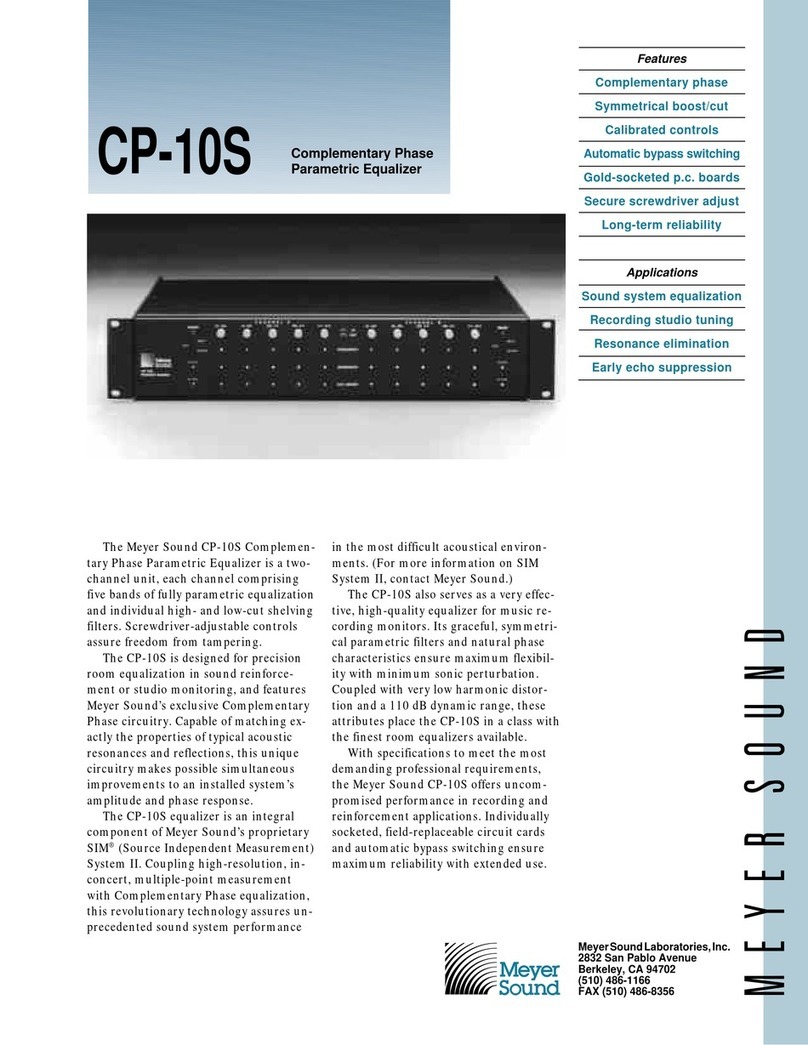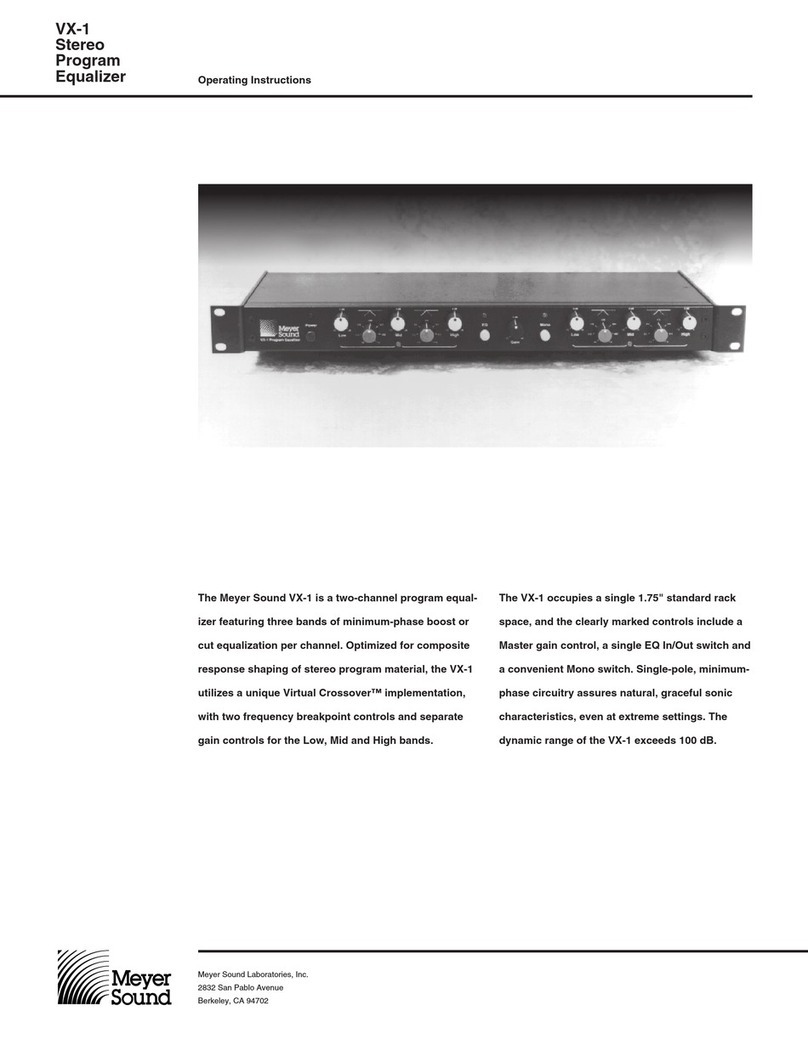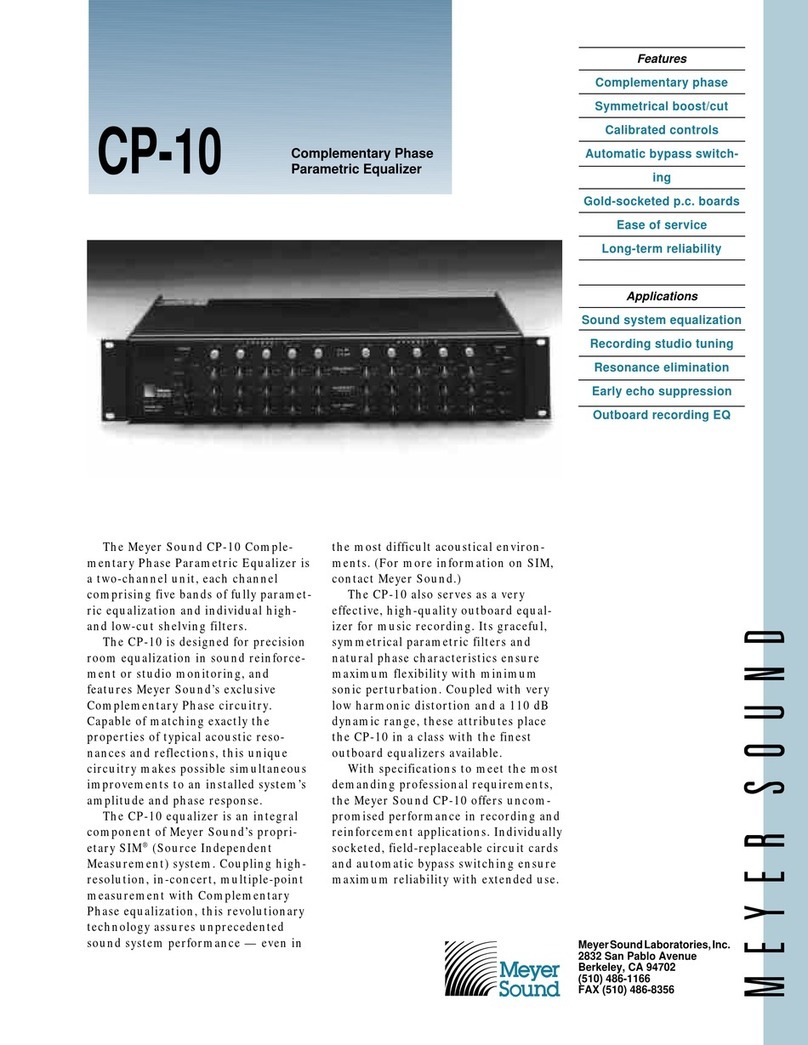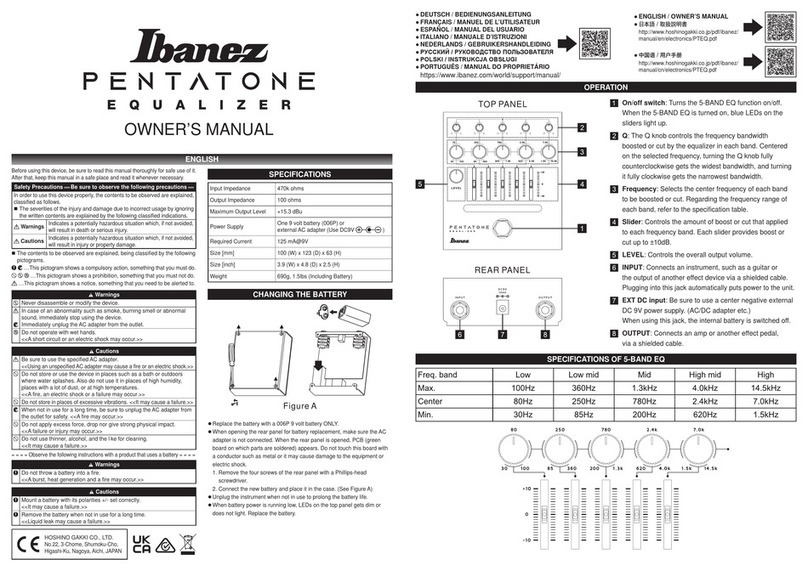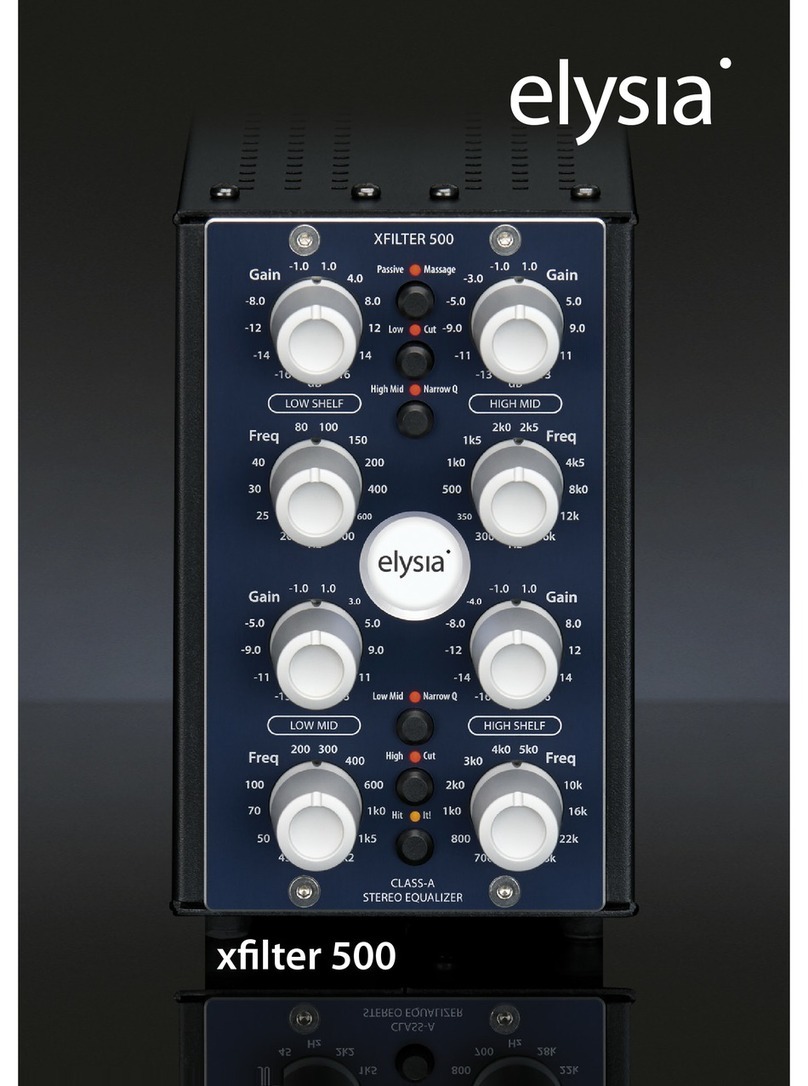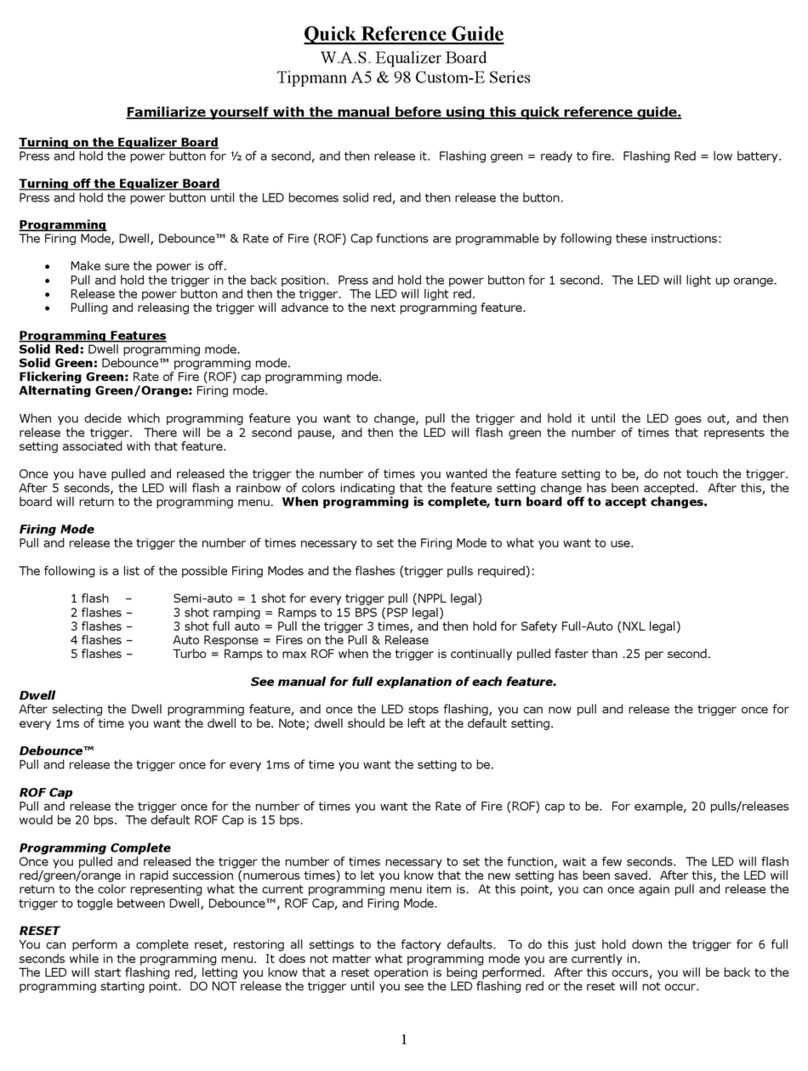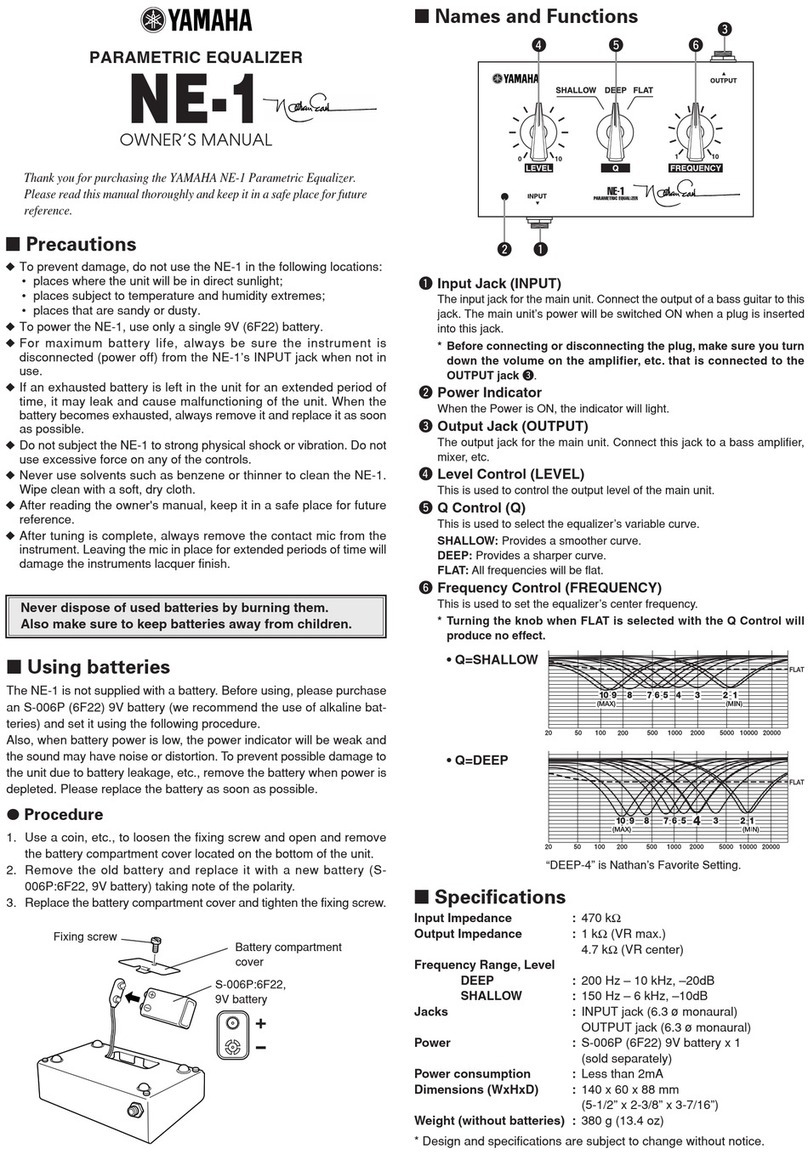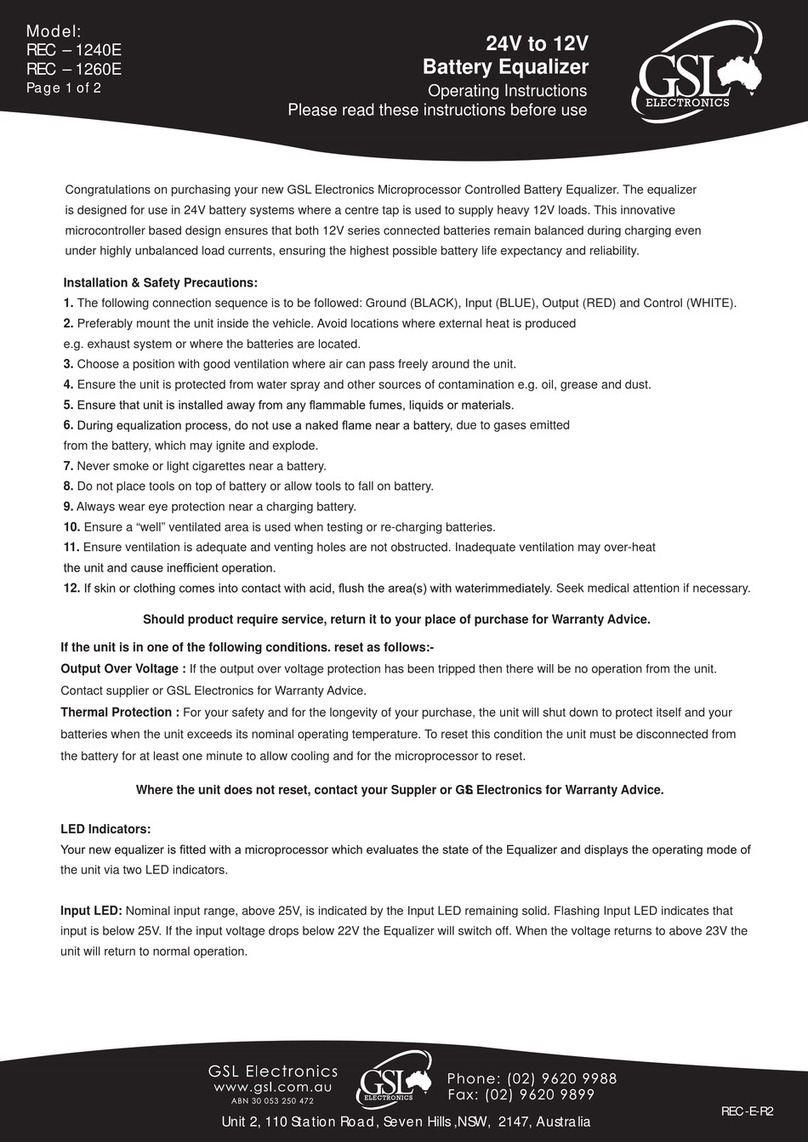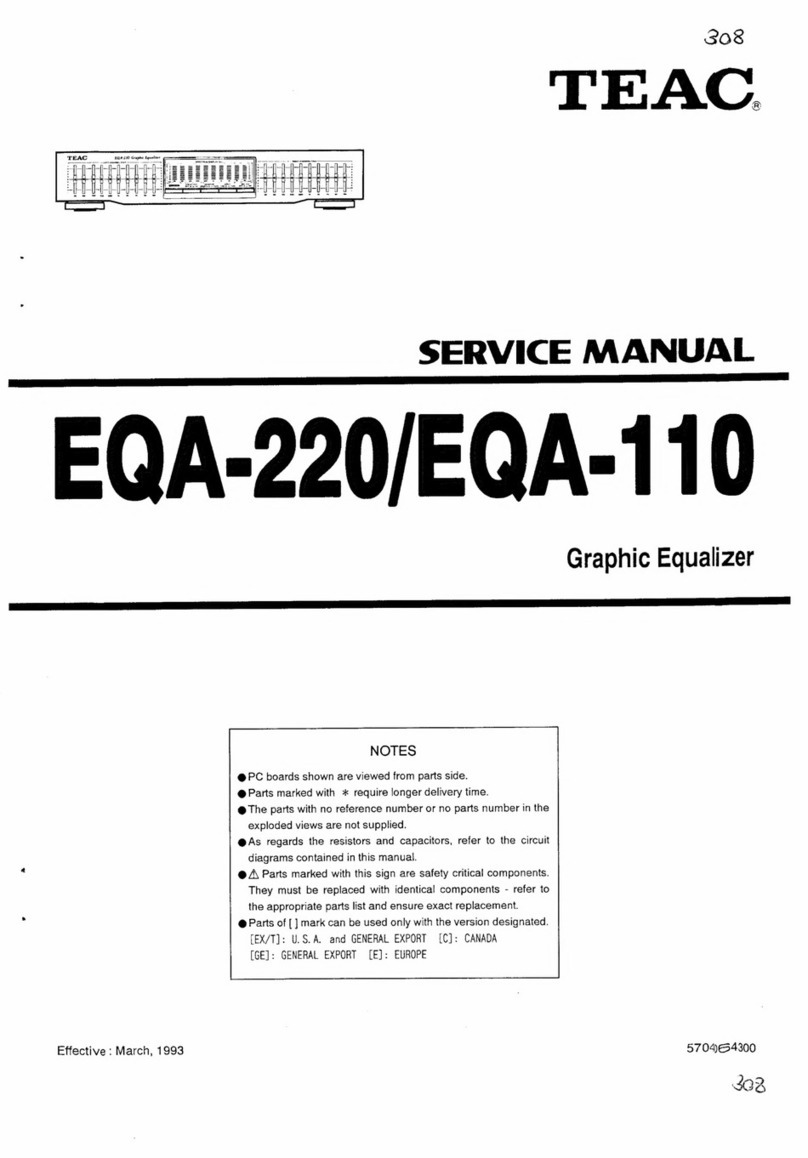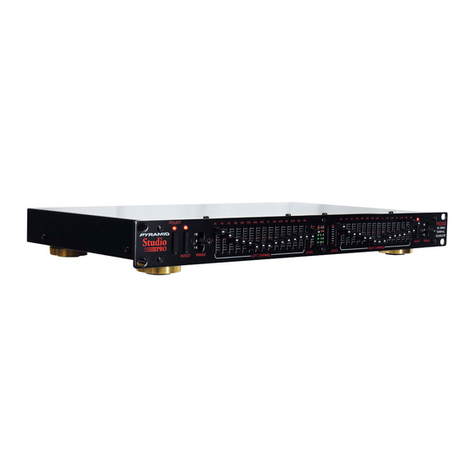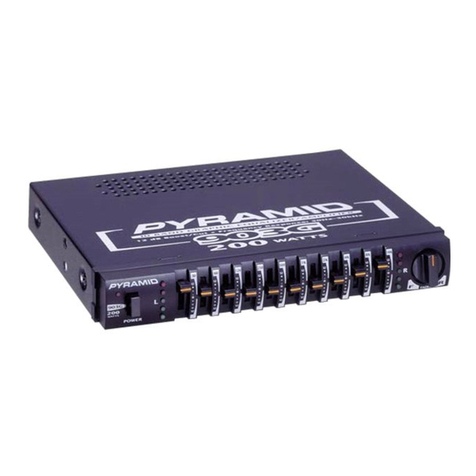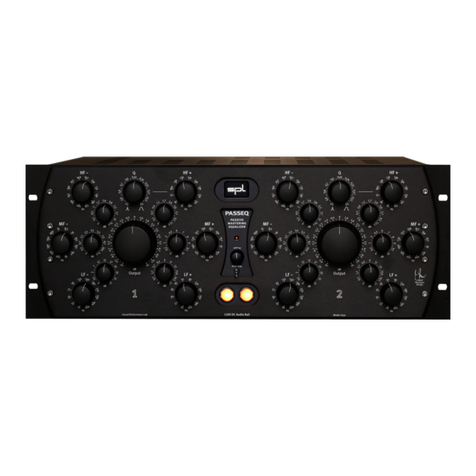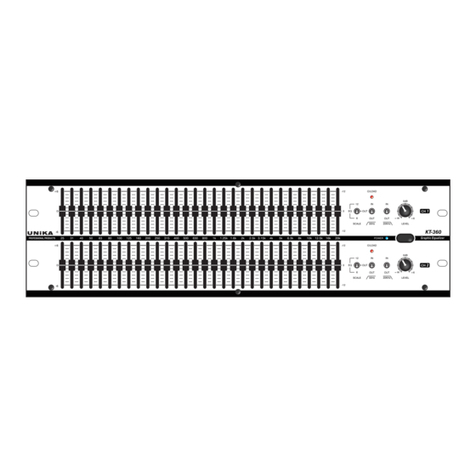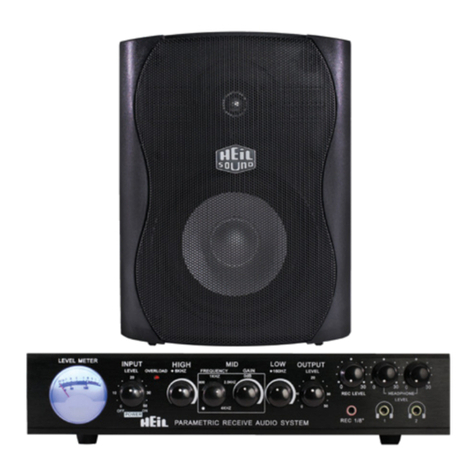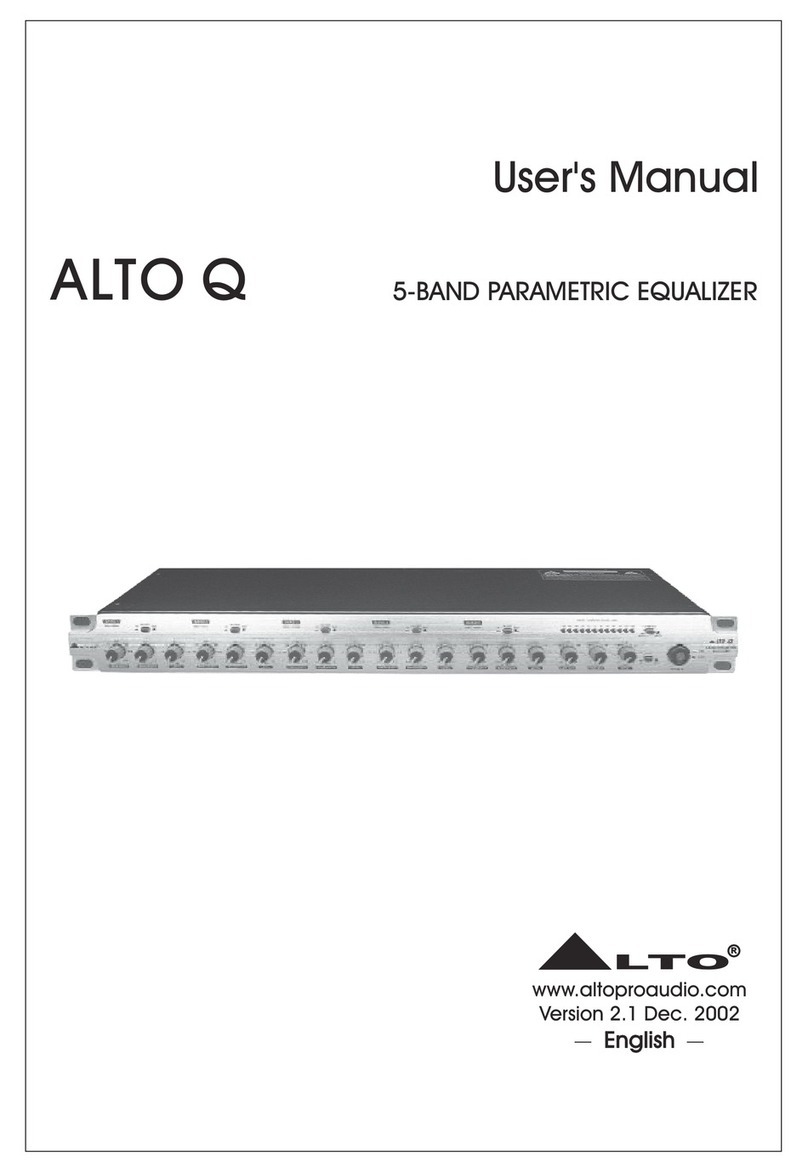Meyer Sound CP-10S User manual

Meyer Sound Laboratories, Inc.
2832 San Pablo Avenue
Berkeley, CA 94702
Operating Instructions
CP-10S
Complementary
Phase
Parametric
Equalizer
The Meyer Sound CP-10S is a ten-band stereo
parametric equalizer featuring five bands of fully
parametric equalization per channel, with an
additional high and low shelving cut filter for
each channel. Any frequency between 60 Hz and
6 kHz can be controlled by two equalization
circuits per channel. Frequencies below 60 Hz
and above 6 kHz are controlled by one equaliza-
tion circuit and one shelving cut filter per chan-
nel.
The front panel occupies 31/2inches of rack
space, and individual In/Out switches are in-
cluded for each band of equalization. There are
separate, screwdriver-adjustable Center Fre-
quency, Bandwidth and Boost/Cut controls. The
complementary phase circuitry assures con-
trolled phase distortion, even at extreme set-
tings, and the dynamic range of the instrument
is better than 110 dB under operating condi-
tions.
The front panel is easily removed, and each of
the fourteen equalization circuits is mounted on
its own gold-socketed removable printed circuit
board, guaranteeing ease of service. LEDs indi-
cate power status and clip levels. Signal pro-
cessing is initiated by a relay that closes only
when the power supplies have stabilized. In the
event of AC failure, the unit automatically
switches to hardwire bypass.

Operating Instructions
Meyer Sound Laboratories, Inc.
2832 San Pablo Avenue
Berkeley, CA 94702
CP-10S
Complementary
Phase
Parametric
Equalizer
Connections
Rear panel connectors are XLR-type and both inputs and
outputs are balanced. An associated rear-panel switch
labeled Balanced/Unbalanced Gain Adjust controls the
unit’s gain to accommodate either unbalanced or balanced
output connections.
In the Unbalanced position, the channel gain is unity when
CP-10S is driving a single-ended device input. In the
Balanced position, the channel gain is unity for a balanced
output connection. When the two channels of the CP-10S
are to be connected in series using a normal two-conductor
shielded microphone cable, the switch should be set to the
Balanced position.
AC Power Inlet and
Voltage Selector Switch
The rear-panel AC input connector is an IEC/CEE Stan-
dard Receptacle. The signal path relay closes only when
power supplies are stable, and once the relay is closed the
unit is inserted into the signal path. In the event of loss of
AC power or unstable line voltage, the CP-10S will auto-
matically remove itself from the signal path into a hardwire
bypass mode. If the unit remains connected to the AC
supply, it will automatically reinsert itself in the signal path
as soon as the power supplies stabilize.
The rear-panel AC inlet is equipped with an integral voltage
selector and a fuse holder, both concealed in a compart-
ment above the AC inlet. The selected voltage is displayed
in a small window and reads 115 VAC or 230 VAC. In
order to change the voltage, first disconnect the AC cord.
Open the door of the voltage-selector compartment using a
small screwdriver or pen-knife and remove the voltage-
selector cam. Rotate the cam and replace it so that the
desired voltage is visible through the window of the voltage
selector compartment door. When the door to the voltage
selector compartment is closed and the AC cord is recon-
nected, the unit is ready for use.
AC Fuse
The fuse holder assembly can accommodate both U.S.
and European size fuses in their respective trays. When
the unit is shipped with the AC voltage set at 115 VAC, the
U.S. size fuse tray and fuse are included (Meyer Sound
Part Numbers 422.006 and 420.002 respectively). Other-
wise the European size fuse tray and fuse are supplied
(Meyer Sound Part Numbers 422.005 and 420.003 respec-
tively), and the voltage-selector cam is set at 230 VAC.
Indicators
The front panel of the CP-10S includes six LEDs. The two
Green LEDs indicate the power status at all times, the LED
marked Power indicating the presence of AC power and
the LED marked Ready that the signal path relay has
engaged and that the selected equalization is in circuit. The
four Red LEDs indicate signal levels in excess of 16 dBv at
the input and output stages of the unit. If the Input Clip LED
for either channel is lit, reduce the level of the input signal.
If the Output Clip LED of either channel is lit, reduce the
amount of gain through the equalizer by reducing the Boost
setting in those equalizer sections that are in use, or
reduce the drive signal level.
Ground Lift Switch
A ground Iift switch on the rear panel lifts pin 1 from the
chassis, which is grounded through the AC connector “U”
ground. This switch may be used to eliminate hum due to
ground loops. Pin 1 on the XLR connectors is tied to signal
common at all times.
Front Panel Controls
Each of the ten tunable filter circuits has its own screw-
driver-adjustable Center Frequency, Bandwidth and Boost/
Cut controls, and each of these filters can be inserted or
removed from the signal path with an In/Out switch.
In/Out Switch
The In/Out switches are provided so that individual filters
may be switched in and out without changing any settings.
The efficacy of particular equalization settings may thus be
easily verified, both by measurement and subjective
evaluation. In the Out position, the signal is not affected in
any measurable way by any of the filter settings. (For
lowest system noise it is recommended that filters not in
use be bypassed using the In/Out switch.)
The rear-panel voltage selector compartment contains a
1
/
4
Amp SIo BIo 250V fuse. In order to replace the fuse, first
disconnect the AC cord. Open the voltage selector com-
partment (see above) and remove the sliding tray which
contains the fuse. When replacing the fuse tray, take care
to insert it in the slot to the right, aligning the printed arrow
with those on the inside door of the voltage selector com-
partment. Close the compartment and reconnect the AC
cord. The unit is now ready for use.

Meyer Sound Laboratories, Inc.
2832 San Pablo Avenue
Berkeley, CA 94702
Operating Instructions
CP-10S
Complementary
Phase
Parametric
Equalizer
Example of
Complementary Phase
Equalization
Effective equalization of loud-
speaker/room resonances re-
quires exact and opposite match-
ing with anti-resonance circuitry.
An example is shown here of the
correction of a response curve
aberration caused by reflection
from a single surface adjacent to
a loudspeaker under test (half-
space loading). All measurements
have been made with Meyer
Sound’s SIM
®
System II.
Figure 1
The test loudspeaker is first
measured in near-free space
conditions (on a stand approxi-
mately six feet off the ground,
away from all other reflecting
surfaces). The upper window
displays the amplitude re-
sponse, and the lower the
phase response. Frequency
resolution is third-octave. The
loudspeaker exhibits very flat
response in both amplitude and
phase.
Figure 2
This display shows the impulse
response (amplitude vs time) of
the test loudspeaker under the
same near-free field conditions.
The upper window is a ±560
msec span, and the lower
window shows the same data
zoomed to a ±56 msec span.
The loudspeaker exhibits a
very controlled and coherent
impulse response.
Figure 3
The loudspeaker is now placed
with its back against a wall,
again at approximately six feet
off the ground. This frequency
response measurement illus-
trates the low-frequency (below
500 Hz) aberrations that half-
space loading typically causes.
Disruptions appear in both the
amplitude and the phase trace.

Operating Instructions
Meyer Sound Laboratories, Inc.
2832 San Pablo Avenue
Berkeley, CA 94702
CP-10S
Complementary
Phase
Parametric
Equalizer
Figure 4
This impulse response mea-
surement of the loudspeaker in
half-space shows that the
frequency-response aberra-
tions of Figure 3 also appear in
the time domain as echoes at
approximately 4 and 8 msec
(note peaks). These are reflec-
tions from adjacent surfaces.
Figure 5
Complementary Phase Equal-
ization is now applied to re-
move the response aberrations
shown in Figure 3. The lower
window shows the unequalized
loudspeaker response (bright
trace) with the inverse of the
equalizer response overlaid
(grey trace). The equalized
loudspeaker measurement
(upper window) shows restora-
tion of the amplitude response.
Figure 6
This is the impulse response of
the corrected test loudspeaker
in half space. The echoes
shown in Figure 4 have been
suppressed, and the impulse
response restored. This is
proper deconvolution, as can
only be performed with
Complementary Phase equal-
ization applied under high-
resolution measurement.

Meyer Sound Laboratories, Inc.
2832 San Pablo Avenue
Berkeley, CA 94702
Operating Instructions
CP-10S
Complementary
Phase
Parametric
Equalizer
Center Frequency
Control
The tunable filters in the CP-10S each have a 10:1 fre-
quency range. Any frequency between 20 Hz and 20 kHz
may be selected for equalization, and the overlap between
filters is such that any frequency between 60 Hz and 6 kHz
can be selected in two filters per channel. This degree of
versatility and precision is most useful when equalizing
resonances that are both narrow in bandwidth and closely
spaced in frequency.
When two filters in the same channel are tuned to the
same frequency, the combined effect is dependent on the
amount of boost of cut selected in each filter and the
bandwidths chosen. When the same center frequency and
bandwidth are chosen, the net effect of the two filters will
be approximately two-thirds of the sum of the boost or cut
of the filters when inserted separately. If a filter is set to
0 dB of boost or cut, then it should be removed from the
signal path using the In/Out switch. This will prevent any
interaction with adjacent filters tuned to the same fre-
quency.
Bandwidth Control
Each of the tunable filters can be adjusted from a minimum
bandwidth setting of 0.1 octave to a maximum of 1.1 oc-
taves. The Bandwidth Control is continuously variable
between these extremes. In combination with the Center
Frequency and Boost/Cut Controls, the Bandwidth Control
makes it possible to complement exactly a resonance or
response peak in order to remove the resonance and
flatten system response.
Boost/Cut Control
The Boost/Cut Control for each of the tunable filters in the
CP-10S is continuously adjustable from 15 dB of Boost to
15 dB of Cut. In the center, the Boost/Cut Control will have
no appreciable effect on the signal unless another filter in
the same channel is tuned to the same frequency. In this
case, the amount of boost or cut available in the active filter
is reduced. It is recommended that filters not in use be
bypassed using the In/Out switch.
High and Low Shelving
Cut Filters
In addition to the tunable filters described above, there are
two shelving cut filters per channel, each with its own
control. The high and low shelving cut filters are so de-
scribed because as each is turned from flat response to
maximum cut, the turnover frequency shifts and the slope
steepens. This provides the user with a flexible tool for
house-curve tailoring or bandwidth limiting. Using the
shelving cut filters at maximum attenuation reduces the
bandwidth of the equalizer to approximately 3 octaves
between 5 kHz and 500 Hz, with a filter slope of 6 dB per
octave above and below those frequencies.
50 100 200 500 1k 2k 5k 10k 20k
Amplitude, 3dB per division
A set of equalization curves showing symmetry at 10 dB boost
and cut (minimum and full bandwidth settings included).
50 100 200 500 1k 2k 5k 10k 20k
Amplitude, 3dB per division
Frequency in Hertz
Frequency in Hertz
A set of equalization curves showing action of high and low
shelving cut filters, from flat to maximum attenuation.

Operating Instructions
Meyer Sound Laboratories, Inc.
2832 San Pablo Avenue
Berkeley, CA 94702
CP-10S
Complementary
Phase
Parametric
Equalizer
Replacing Filter Modules
The CP-10S front panel is secured to the chassis with four
6-32 x
5
/
16
" black flat-head machine screws which can be
removed using a No. 2 Philips screwdriver. Once the
screws are removed, the front panel can be slipped over
the filter control shafts without disturbing any of the set-
tings. This feature makes it possible to replace individual
filter circuits without removing the unit from its installed
position, though it is recommended that AC power be
disconnected before removing any filters. The CP-10S will
operate with any or all of the tunable filter cards removed,
so the unit may be relied on to operate usefully with a
minimum of filter cards.
Rack Mounting End
Plates and Security
Window
The CP-10S is supplied with rack-mounting end plates
which are designed to hold the unit in a standard 19" rack.
These end plates are fastened to the chassis of the CP-
10S with four 6-32 x
5
/
16
" black flat-head machine screws,
and can be mounted in two positions. In the standard
position, the unit’s faceplate is nearly flush with the rack
ears, making for ease of adjustment. In the alternative
position, the unit is recessed from the rack mount. For
additional protection, a smoked acrylic Security Window
Kit is available (Meyer Sound Part Number 66.101.017.01)
which is secured to the unit using the supplied brackets
and fasteners.
Specifications
Frequency Response
1
Input Type
Output Type
Maximum Input Level
Maximum Output Level
2
Total Harmonic Distortion
2,3
Hum and Noise
Dynamic Range
Indicators
Power
Ready
Clip (Input and Output)
Controls
Front Panel
Rear Panel
Connectors
Input/Output
Power
Physical Dimensions
Weight
20 Hz to 20 kHz ±0.5 dB
Balanced (active) 20k ohms
Active push-pull, will drive 600 ohms
+20 dBv
+20 dBv
Less than 0.01%
-90 dBv (“A” weighted)
110 dB normal operating conditions, all filters in circuit
Green LED
Green LED
Red LEDs
EQ In/Out switch
Center Frequency control
Bandwidth control
Boost/Cut control
Lo and Hi Shelving Cut control
Ground Lift switch
XLR-type (A-3) female/male
115/230 VAC (rear panel switchable)
19"W x 3
1
/
2
"H x 8
1
/
2
"D
10 lbs (4.6 kg)
Notes
1) All EQ ciruits switched out
2) All EQ circuits engaged, unity
gain
3) +4 dBv drive at 1 kHz
Meyer Sound Part Number 05.101.029.03 Revision A, January 1994
© Meyer Sound 1994. All rights reserved. This document may not be reproduced without permission.
Table of contents
Other Meyer Sound Stereo Equalizer manuals
